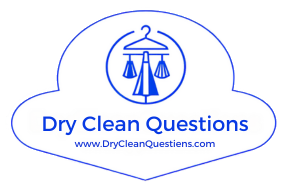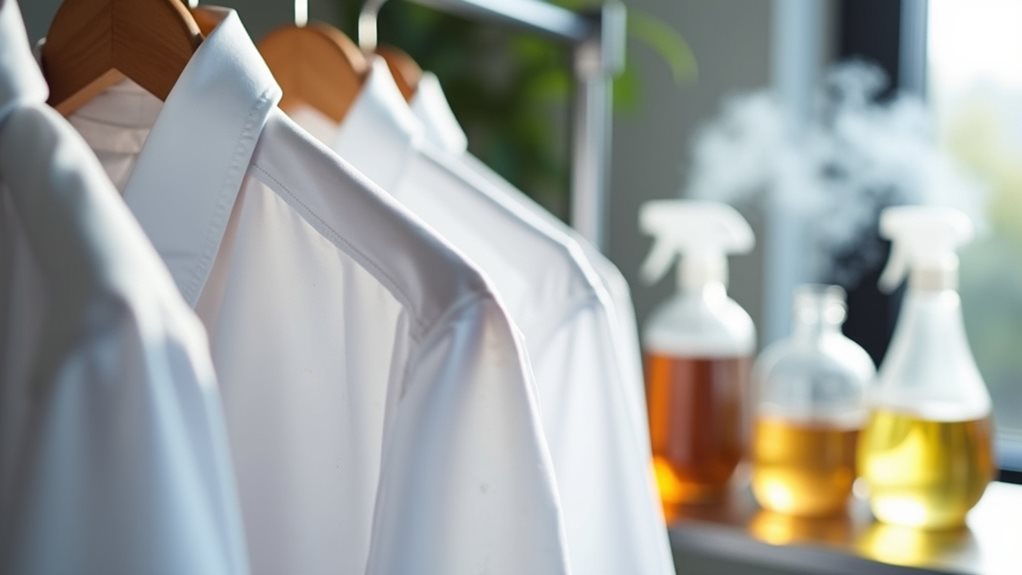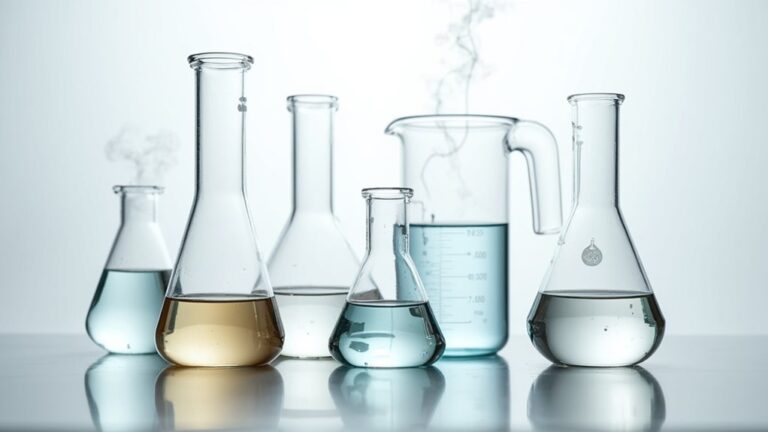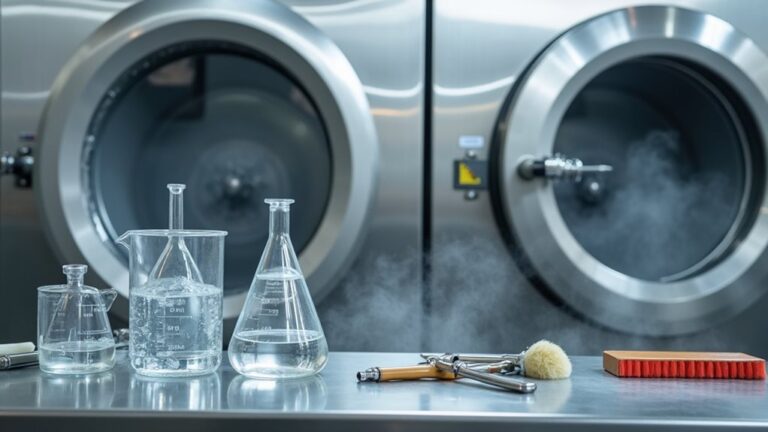Traditional dry cleaning isn’t particularly safe for your health, as most cleaners still use PERC, a chemical that’s been linked to bladder cancer, non-Hodgkin lymphoma, and neurological issues. I learned this the hard way when I started getting headaches after picking up my blazers – turns out those residual chemicals on freshly cleaned clothes can cause skin irritation and respiratory problems too. Fortunately, there are safer eco-friendly alternatives and smart at-home methods that’ll protect both you and your favorite garments.
What Chemicals Are Used in Dry Cleaning
For decades, I naively dropped off my favorite blazers and delicate dresses at the dry cleaner without giving a second thought to what chemicals were actually being used to clean them, and honestly, I wish I’d been more curious sooner.
The primary culprit is PERC (perchloroethylene), a solvent that’s been linked to serious health risks including non-Hodgkin lymphoma and multiple myeloma.
While alternatives to PERC like n-propyl bromide exist, they’re often just as problematic, creating exposure limits concerns for dry cleaning workers who handle these toxic chemicals daily.
Many PERC alternatives aren’t actually safer, putting dry cleaning workers at risk from daily exposure to equally toxic chemicals.
The environmental impact extends beyond the shop too, with PERC contaminating air and groundwater.
Thankfully, eco-friendly alternatives like liquid silicone are emerging, offering safer cleaning without compromising your wardrobe’s integrity.
Beyond worker safety, customers who wear freshly cleaned garments can experience neurological symptoms and respiratory irritation from chemical residues that remain on clothing.
Health Risks of Perchloroethylene and Other Solvents
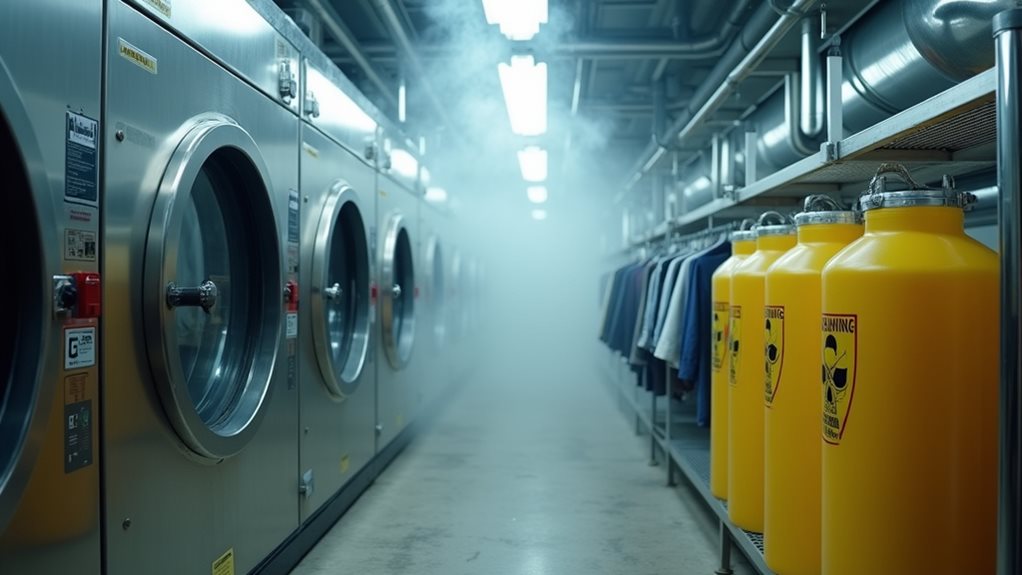
You’ll want to know that PERC, the most common dry cleaning solvent, isn’t just a minor concern—it’s classified as a probable human carcinogen that’s been linked to liver, kidney, and bladder cancers, making me think twice about those weekly trips to the cleaners 😬.
Your exposure doesn’t end when you pick up your clothes either, since PERC residue can linger on fabrics and release vapors into your home, creating an ongoing health risk that many people, including myself until recently, never really considered.
While alternative solvents might sound safer, they come with their own set of potential dangers, which means understanding these risks becomes essential for making informed decisions about your clothing care routine.
Beyond cancer risks, PERC exposure can cause immediate health problems including skin irritation and respiratory issues, particularly when clothes aren’t properly aired out after cleaning.
PERC Cancer Links
When I first learned that the chemical responsible for getting my favorite blazer crisp and clean was classified as a probable human carcinogen, I’ll admit I felt a bit betrayed by my trusted dry cleaner 😅.
PERC’s cancer links aren’t just theoretical concerns—they’re documented health risks that affect real people. The Environmental Protection Agency has connected this solvent to specific cancers that should make you think twice about frequent dry cleaning exposure.
Here’s what research shows about PERC’s cancer connections:
- Bladder cancer risk increases with prolonged exposure to dry cleaning solvents
- Non-Hodgkin lymphoma has been linked to PERC in multiple studies
- Dry cleaning workers show markedly higher cancer mortality rates
- Residual chemicals on your clothes create ongoing exposure risks
- Multiple cleanings compound the problem by increasing chemical residue
Beyond cancer risks, PERC exposure has also been linked to neurological problems, liver damage, and reproductive issues that can affect your overall health.
Understanding these connections helps you make informed decisions about protecting your health.
Alternative Solvent Dangers
While PERC dominates the dry cleaning conversation, it’s not the only solvent lurking in your neighborhood cleaner that could impact your health.
N-propyl bromide, often marketed as a “safer” alternative solvent, brings its own troubling baggage—acute exposure can leave you feeling dizzy and nauseous, while researchers classify it as a possible carcinogen.
These volatile organic compounds don’t just affect you during pickup; they contribute to widespread environmental contamination that circles back to impact entire communities.
Whether you’re dealing with PERC’s well-documented health effects or these supposedly “better” alternatives, chronic exposure remains a genuine concern.
The truth is, swapping one problematic chemical for another slightly less problematic one isn’t the victory lap the industry wants you to believe it is.
Fortunately, some facilities are moving toward genuinely safer options like wet cleaning, liquid CO2, and hydrocarbon solvents that reduce these health risks significantly.
Environmental Impact of Traditional Dry Cleaning
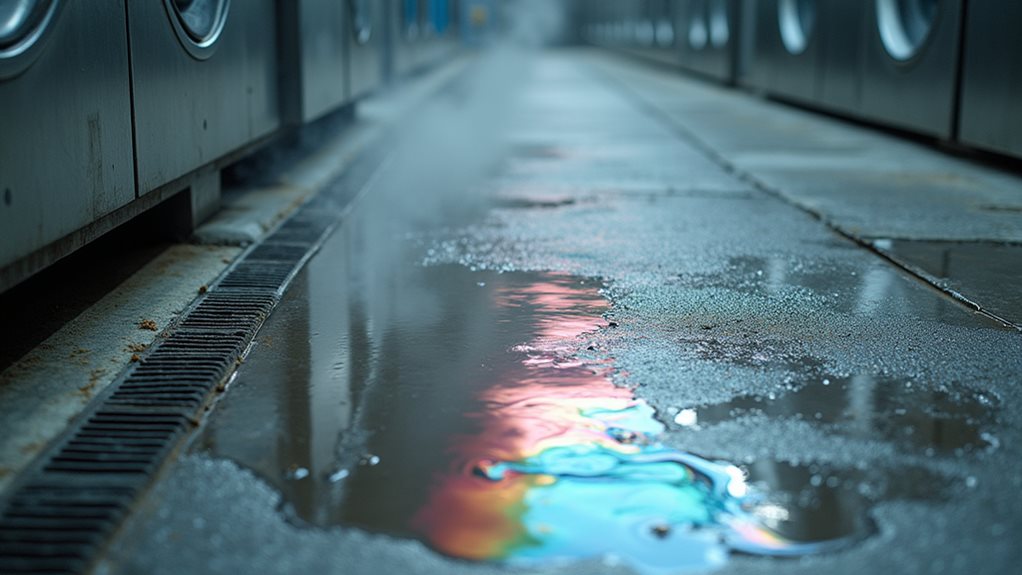
Beyond the personal health concerns that might keep you up at night, traditional dry cleaning creates a ripple effect of environmental damage that extends far beyond the storefront where you drop off your favorite blazer.
PERC doesn’t just stay contained within those industrial machines—it escapes into our shared environment, creating lasting consequences that affect entire communities.
The environmental impact of this carcinogen includes:
- Air pollution that spreads throughout neighborhoods surrounding dry cleaning facilities
- Groundwater contamination that threatens local drinking water supplies for years
- Ecosystem disruption where plants and wildlife struggle to recover from exposure
- Regulatory efforts forcing industry-wide changes due to mounting health risks
- Long-term soil contamination that persists even after facilities close
The dry cleaning industry’s reliance on PERC means your clothing choices inadvertently contribute to environmental degradation that outlasts any garment’s lifespan.
Fortunately, many modern cleaners now offer biodegradable solvents and other eco-friendly alternatives that significantly reduce these environmental impacts.
How Chemical Residues Affect Your Clothing

Although you might assume that picking up your freshly cleaned clothes marks the end of your chemical exposure, the reality is that PERC residues cling to your garments like an unwelcome houseguest who refuses to leave.
When you wear those freshly pressed shirts, perchloroethylene (PCE) continues vaporizing into your home’s environmental air, creating ongoing exposure to this probable carcinogen.
Different fabrics tell different stories—wool and cotton hold onto chemical residues more stubbornly than silk, which practically shrugs off contamination.
Here’s what really concerned me: multiple trips to dry cleaning services actually increase these health risks over time.
The good news? Proper storage in well-ventilated areas helps your clothing breathe and release lingering chemicals before they reach your skin. 🌬️
Many dry cleaning facilities are now switching to safer alternatives like wet cleaning and liquid CO2 to reduce customer exposure to harmful chemicals.
Safer Alternatives to Conventional Dry Cleaning

Since discovering the health risks lurking in traditional dry cleaning, I’ve become something of a detective in the world of fabric care alternatives.
My journey into safer fabric care began the moment I realized what toxic chemicals were hiding in my freshly dry-cleaned clothes.
Honestly, the options available today would make my grandmother’s generation envious.
These safer alternatives have revolutionized how I approach garment care, offering eco-friendly solutions that actually work:
- Liquid silicone (D5) cleaning – Non-toxic, biodegradable, and gentle on fabrics
- Wet cleaning processes – Computer-controlled systems using specialized detergents
- Propylene glycol ethers – No adverse health effects, completely biodegradable
- At-home dry cleaning kits – Perfect for rejuvenating lightly soiled items
- Steamers – Effectively remove odors and stains without harsh chemicals
I’ve tested most of these methods myself, and while they require slight adjustments to your routine, the peace of mind knowing you’re not exposing yourself to harmful chemical residues makes every extra step worthwhile.
For regular maintenance, steam cleaning uses high-temperature water vapor to effectively remove dirt and odors without any chemical exposure whatsoever.
When Professional Cleaning Is Actually Necessary

You’ll discover that some garments genuinely need professional care, not because the industry wants your money, but because your beaded evening dress or structured blazer will literally fall apart in your washing machine.
When I learned this the hard way after destroying a vintage jacket with delicate embroidery, I realized that certain fabric constructions, intricate embellishments, and stubborn stains require the specialized equipment and expertise that only professional cleaners possess.
Understanding when to surrender control and trust the pros can save you from expensive mistakes, preserve your favorite pieces longer, and honestly give you one less thing to worry about in your already busy life.
Dry cleaning uses chemical solvents instead of water to remove dirt and stains while preserving the integrity, shape, and texture of delicate materials like silk, wool, and cashmere that would otherwise suffer damage or shrinkage in traditional washing.
Embellished Garment Requirements
When you’re staring at that gorgeous beaded dress hanging in your closet, the one you splurged on for your cousin’s wedding last year, you might be tempted to toss it in the washing machine with everything else – but trust me, I learned this lesson the hard way when I watched my favorite sequined top emerge from the washer looking like it had been through a glitter explosion gone wrong.
Embellished garments demand special attention because traditional washing methods create chaos for delicate fabrics.
Here’s what you need to know:
- Always check care labels first – they’re your roadmap to damage prevention
- Professional dry cleaners have specialized equipment for intricate embellishments
- Heat and agitation cause beads and sequins to loosen catastrophically
- Eco-friendly dry cleaning reduces exposure to harsh chemicals used in traditional processes
- Consulting experts about appropriate cleaning methods protects your investment
The dry cleaning process uses chemical solvents instead of water, which effectively removes oils and grease while preserving the fabric’s texture and preventing damage to delicate embellishments.
Your health matters, but so does preserving those special pieces that make you feel amazing.
Fabric Structure Considerations
Beyond just embellishments, the very fabric of your clothing holds secrets about whether it can survive a trip through your washing machine. I discovered this truth rather dramatically when I confidently threw my grandmother’s vintage wool blazer into a regular wash cycle, only to pull out what looked like a doll-sized jacket that wouldn’t fit my ten-year-old niece.
Your fabric structure determines everything—delicate materials like silk and wool literally can’t handle water’s harsh reality. While concerns about toxic substances and chemicals make us question whether dry cleaners use safe methods for our health, sometimes professional cleaning becomes necessary for environmental protection of your garments.
Dry-clean-only clothing exists because these fabrics need specialized care that preserves their integrity without causing irreversible damage. Professional dry cleaning uses chemical solvents instead of water to safely remove dirt and stains while maintaining the fabric’s original structure and appearance.
Stain Complexity Assessment
How many times have you stared at a mysterious stain on your favorite shirt, wondering if this is the battle where your home cleaning arsenal finally meets its match?
Sometimes, despite our best intentions and every stain remover in our arsenal, certain situations genuinely require professional cleaning expertise.
Here’s when you should seriously consider professional help:
- Oil-based stains that resist water-based cleaning methods at home
- Garments with embellishments where delicate nature makes home washing risky
- Set-in stains from wine, ink, or blood that need specialized treatment
- Silk or wool items requiring cleaning without water exposure
- “Dry clean only” labels that manufacturers specify for fabric preservation
While concerns about exposure to increased cancer risks from chemicals commonly known as PERC exist, many cleaners now offer environmentally friendly alternatives.
Consulting with a dry cleaner about health and environmental options helps you make informed decisions.
At-Home Care Methods for Delicate Garments
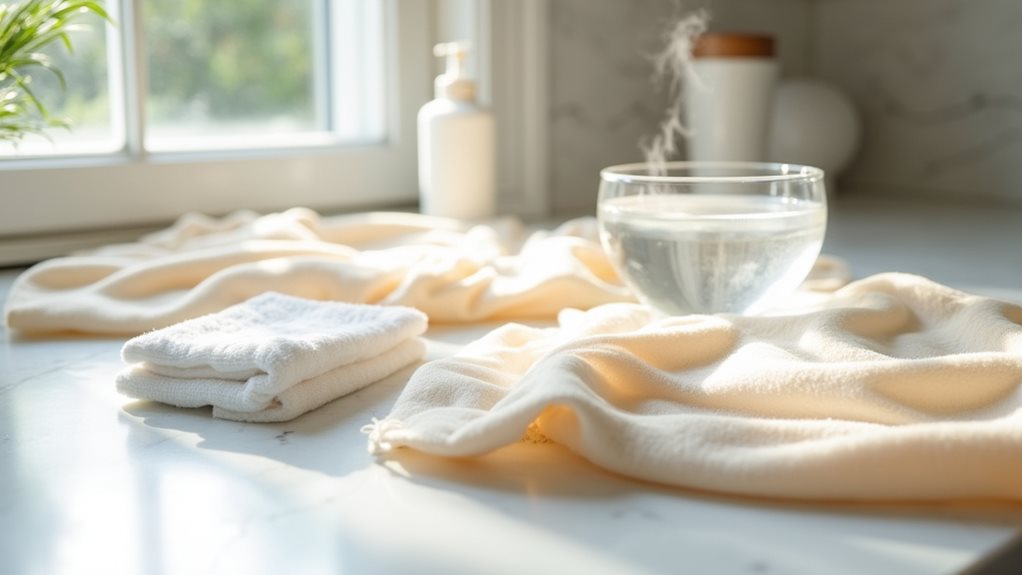
What if I told you that most of those intimidating “dry clean only” labels are actually more like gentle suggestions than absolute commands, and that you can safely care for many delicate garments right in your own home?
I’ve discovered that gentle hand washing with cool water works wonders for most supposedly “untouchable” pieces. Start by pre-treating stains with a quality remover, then wash similar fabrics together to prevent color bleeding.
The secret lies in preserving fabric quality through patience—never wring out your delicate garments, which destroys their shape faster than my teenage attempts at ironing 😅. Instead, roll them gently in a towel to remove excess moisture, then welcome air drying.
These at-home care methods have saved me countless trips to the cleaner.
